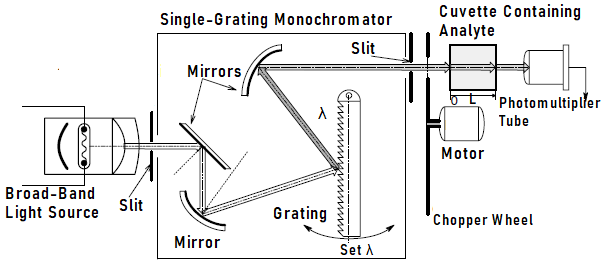Dispersive spectrometry (DS) methods make up a large number of ultraviolet, visible light and infrared spectroscopy systems. DS refers to the fact that the light or electromagnetic radiation passed through the sample (analyte) must pass through a monochromator either before or after the analyte, to describe the analyte’s absorption/transmission characteristic spectrum.
A simplest monochromator is a prism followed by a slit to select a narrow band of wavelengths around some wavelength (λ0). A beam of “white” light is directed into the prism and a fan shaped beam of light, dispersed by wavelength, exits the prism. The desired λ0 is selected by rotating the prism. The slit defines the desired wavelength band. Modern-day monochromators use one or two diffraction gratings which consist of a glass plate into which are etched very fine, closely spaced, parallel lines. Refraction, reflection and interference occur when a beam of white light impinges on a grating, creating an output light beam with a peak λ0, which is dependent on the incident and exit angles. A grating output generally has a higher Q (peak power wavelength λ0/half power wavelength width) than a prism, and by employing two gratings in series one can get an even more spectrally pure output beam, though at the expense of intensity.
A single beam spectrophotometer is illustrated below:

With a reference to the above figure, white light from a tungsten or halogen source is directed to a grating. The exit slit further increases the Q of the exit beam, which is passed through a chopper wheel which periodically interrupts the beam. The chopping rate is usually in the hundreds of pps. The chopped beam then passes through a solution of the analyte in a special chamber referred to as a cuvette. The light path through the analyte in the cuvette is L cm, where L can be 0.1, 1, 2, 10 cm, and so on, depending on the absorptivity of the solution. The exiting light power from the cuvette is measured by a calibrated photomultiplier tube (PMT). The PMT dc dark current is rejected by the phase sensitive rectifier (PSR), which responds only to the ac (chopped) signal from the PMT. The intensity of the light source must be stabilized by using a regulated dc power supply.
The test beam’s λ0 is selected by varying the grating angle. Unfortunately, as λ0 is varied, so does the intensity of the input beam to the cuvette. To compensate for this effect, a run is made with a cuvette full of distilled water or a reference solution, and the emerging radiant reference power as function of wavelength: PoutRef(λ) recorded and used to compensate for the run with the analyte. A phase sensitive demodulator is used to detect PoutAn(λ) and a computer calculates A(ξ), A(λ), T(ξ) or T(λ). Where:
A – A fraction of incident energy absorbed.
Find out more about: Fingertip Pulse Oximeter Blood Oxygen Saturation Monitor
ξ – Wavenumber.
T – A fraction of incident energy transmitted.
λ – Wavelength.
A (ξ) in this case for example, implies calculating A as a function of ξ.
Related articles:
- Spectrophotometry Instrumental Method of Analysis
- How Flame Photometers are used in Chemical Analysis
- How Spectrofluorimeters are used in Biomedical Measurements
- The Role of Biomedical Analysis in Medical Diagnosis
- Flame Atomic Absorption Spectrometry

Leave a Reply
You must be logged in to post a comment.